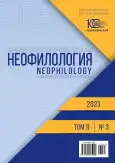Genius of poetic expression. Part one (Based on the publicistic article by S.N. Sergeev-Tsensky “Gogol as an artist of the word”)
- Authors: Khvorova L.E.1
-
Affiliations:
- Derzhavin Tambov State University
- Issue: Vol 9, No 3 (2023)
- Pages: 561-572
- Section: RUSSIAN LITERATURE AND LITERATURE OF PEOPLES OF RUSSIAN FEDERATION
- URL: https://journal-vniispk.ru/2587-6953/article/view/295731
- DOI: https://doi.org/10.20310/2587-6953-2023-9-3-561-572
- ID: 295731
Cite item
Full Text
Abstract
In the aspect of the “scientific-research dialogue” of the author of this study with the writer of the twentieth century Sergei Nikolaevich Sergeev-Tsensky, his publicistic miniatures “Gogol as an artist of the word” (1952), “Talent and genius” (1957), included in the collection “Work hard and joyfully”. It is emphasized that the writer’s work the of the twentieth century Sergeev-Tsensky was written as a pedagogical parting word to future generations and as a call to cherish and study their native Russian language, to cherish the Russian word on the material of the “genius of artistic expression” Nikolai Vasilyevich Gogol. The stylistic and poetic findings of the writer in various stories, in the poem “Dead Souls” and in the dramatic work – the comedy “The Government Inspector” are considered. The ways of creating a literary portrait and landscape, the language system means in depicting the psychological details of the portrait and landscape characteristics of comic heroes (on the example of the portrait of Sobakevich), as well as the speech characteristics of the “The Government Inspector” are investigated. Attention is drawn to Gogol’s techniques of “style play” and some deliberate violations of lexical norms in the construction of portrait characteristics in order to emphasize very significant psychological details. As an addition to Sergeev-Tsensky’s reasoning, the specifics of Gogol’s descriptiveness in the real and the fantastic synthesis are specified on the example of significant details, for example, the story “Viy” from the “Mirgorod” cycle. The fear of the author of “Mirgorod” and “Taras Bulba” of confusion in the minds of the characters of Divine and demonic forces is emphasized.
About the authors
L. E. Khvorova
Derzhavin Tambov State University
Author for correspondence.
Email: xworowa.mila@yandex.ru
ORCID iD: 0000-0002-8720-7906
Dr. habil. (Philology), Professor, Professor of Russian Language Department
33 Internationalnaya St., Tambov, 392000, Russian FederationReferences
- Sergeev-Tsenskii S.N. Trudites’ mnogo i radostno: Izbrannaya publitsistika [Work Hard and Joyfully: Selected Journalism]. Moscow, Molodaya gvardiya Publ., 1975, 334 p. (In Russ.)
- Vinogradov I.A. Letopis’ zhizni i tvorchestva N.V. Gogolya (1809–1852). S rodoslovnoi letopis'yu (1405–1808): v 7 t. [Nikolai Gogol’s Life and Work Chronicle (1809–1852). With Pedigree Chronicle (1405–1808): in 7 vols.]. Moscow, A.M. Gorky Institute of World Literature of Russian Academy of Science Publ., 2017, vol. 1, 736 p. (In Russ.) https://elibrary.ru/zprzkr
- Voropaev V.A. Nikolai Gogol’: Opyt dukhovnoi biografii [Nikolai Gogol: The Experience of a Spiritual Biogra-phy]. Moscow, 2014, 336 p. (In Russ.)
- Vinogradov I.A. (ed. prep.). Neizdannyi Gogol’ [Unpublished Gogol]. Moscow, Nasledie Publ., 2001, 660 p. (In Russ.)
- Vinogradov I.A. Gogol’ v Nezhinskoi gimnazii vysshikh nauk: iz istorii obrazovaniya v Rossii [Gogol in the Nezhinsky Grammar School of the Higher Sciences: from Pedagogics History in Russia]. Moscow, A.M. Gorky Institute of World Literature of Russian Academy of Science Publ., 2015, 351 p. (In Russ.) https://elibrary.ru/uniaml
Supplementary files










